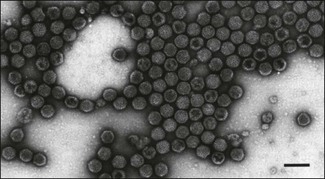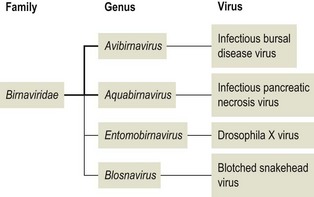Chapter 56 Birnaviruses derive their name from the two segments of linear, double-stranded RNA that make up their genome. The virions are non-enveloped, about 65 nm in diameter with icosahedral symmetry (Fig 56.1). Five polypeptides, VP1, VP2, VP3, VP4 and VP5 have been identified. The major capsid protein VP2 contains the virus neutralizing epitopes and is the type-specific antigen. Replication occurs in the cytoplasm of host cells and involves a virion-associated RNA-dependent RNA polymerase (VP1). The family is divided into four genera (Fig. 56.2); Aquabirnavirus and Blosnavirus contain viruses of fish while Avibirnavirus and Entomobirnavirus contain viruses of chickens and insects respectively. The virions are resistant to ether and chloroform, and stable at pH 3 to 9 and 60°C for one hour. Figure 56.1 Negative contrast electron micrograph of IBDV virions. The bar represents 100 nm. Reprinted with permission: Fauquet, C.M., et al. (Ed.), 2005. Virus Taxonomy Eighth Report of the International Committee on Taxonomy of Viruses. Elsevier Academic Press. 2. Variant serotype 1 isolates were first recognized in the United States in the mid-1980s in flocks that had been vaccinated with classical strain vaccines. These antigenic variants are highly immunosuppressive in young chicks, causing rapid bursal atrophy without clinical signs of disease. 3. Very virulent (vv) serotype 1 strains were first reported in Europe and Asia in the late 1980s. These vvIBDV strains are similar antigenically to classical serotype 1 strains but have caused disease even in the presence of maternal antibody induced by classical vaccine strains.
Birnaviridae

Infectious bursal disease
![]()
Stay updated, free articles. Join our Telegram channel

Full access? Get Clinical Tree



